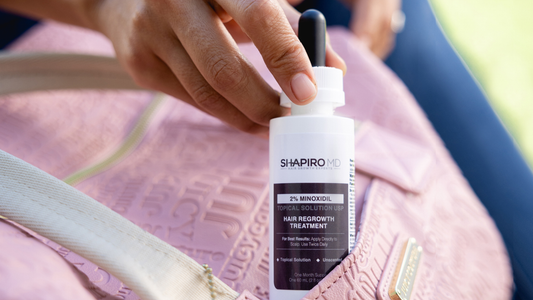Finasteride (brand name Propecia®) is a prescription-only oral medication for treating androgenic alopecia (male pattern hair loss) in men. It is one of the most effective forms of hair loss treatment, and it’s been used for decades by millions of men around the world.
The FDA-approved prescribing label for finasteride indicates that men should take finasteride daily for at least three months before seeing observable results. Sustaining finasteride benefits requires continued use, with dermatological re-evaluations recommended every four to six months.
Finasteride is effective for the majority of men who try it.
Summary
- Finasteride is an oral, prescription medication for hair loss in men. It is one of the most effective approaches to slowing and reversing hair loss, and it is the only oral medication approved by the FDA for this indication.
- Finasteride stays in your system for a short time following discontinuation of use--typically three to four days. It reaches peak blood plasma levels in about 2 hours.
- Finasteride needs to be taken continuously, or hair growth will stop and hair loss will begin again. Finasteride may cause side effects involving low libido and erectile dysfunction.
Evaluating the length of time finasteride remains in the body is performed by analyzing semen. A study involving 35 males taking 1mg of finasteride per day for six weeks found that 60 percent of the men did not have detectable finasteride levels in their system after they stopped taking finasteride for several days.
Finasteride also reaches peak levels in the bloodstream (peak plasma levels) after 1 to 2 hours of taking it.
Studies show that the bioavailability of 1mg finasteride tablets is approximately 65 percent. This means that 65 percent of the finasteride contained in one pill is absorbed and utilized by the body.
Men who have hair regrowth with finasteride but decide to stop taking the medication typically experience a reversal of effects within one year. Although the standard dose of finasteride is 1mg per day, studies have shown that taking single doses of 70mg to 80 mg per day for three months does not cause adverse side effects. In addition, there have been no instances of anyone overdosing on finasteride.
How Does Finasteride Work? Mechanism of Action for Finasteride
Finasteride treats male pattern hair loss by preventing the conversion of the androgen hormone testosterone into dihydrotestosterone (DHT).
The enzymes responsible for converting testosterone into DHT are called Type I 5 reductase and Type II 5 reductase.
Found mainly in the sebaceous glands, large areas of the skin, the prostate, and hair follicles, these two enzymes can produce excess amounts of DHT that shrink hair follicles and provoke male pattern hair loss.
By decreasing DHT levels in the body and scalp, finasteride enlarges hair follicles while stimulating new hair growth in men with androgenic alopecia. Lowering DHT amounts in the scalp also increases or at least maintains the number of hairs in the anagen phase of hair growth. Although finasteride is most effective in growing hair on the crown of the head, it can also inhibit further hair loss over other areas of the scalp.
Studies reveal that after taking a 1mg finasteride tablet, most men reach 65 percent suppression of circulating DHT levels within 24 hours.
Additionally, finasteride does not change circulating levels of thyroxine (thyroid-stimulating hormone), cortisol, or cholesterol in healthy men.
How is Androgenic Alopecia Diagnosed?
Before doctors prescribe finasteride for male pattern hair loss, they will make sure hair loss is not due to other conditions. In some cases, blood tests, skin biopsies, or other tests may be needed to make an accurate diagnosis, though male pattern hair loss is usually the assumed diagnosis for aging men who are showing signs of hair loss.
Finasteride cannot treat hair loss caused by chemotherapy, severe scalp infections, or alopecia areata.
The primary cause of male pattern hair loss is genetics. If there is a family history of androgenic alopecia in a man's family, they likely carry the gene responsible for this specific type of hair loss--a gradual receding of the hairline followed by the development of bald spots and a horseshoe pattern of thinning hair around the head.
Who is a Good Candidate for Finasteride for Hair Loss?
So you’re asking, “can I take finasteride?”
Finasteride is considered a first-line treatment for male pattern hair loss. Dermatologists sometimes recommend combining finasteride and other topical solutions like minoxidil or Shapiro MD solutions to enhance the effects of finasteride.
Nearly 80 percent of Caucasian men in the U.S. experience various degrees of male pattern baldness, with most men seeing initial hair loss attributed to androgenic alopecia around age 40. Some begin noticing the classic signs of male pattern hair loss as early as their late 20s--a receding hairline that gradually starts taking a horseshoe shape.
If someone cannot take finasteride or finasteride isn't providing desired results, there are some other options. Minoxidil is a capable and clinically proven hair loss treatment, and natural DHT fighting ingredients like saw palmetto are used in some shampoos and conditioners. Another alternative to treating hair loss is hair transplant surgery. According to the American Society of Plastic Surgeons, candidates for hair transplant surgery must have enough healthy hair growing on the sides and back of the head to provide donor hair.
Can Women Take Finasteride?
Currently, the only FDA-approved treatment for hair loss in women (female pattern hair loss) is the topical application of minoxidil.
Since finasteride has been shown to exert potentially harmful effects on the fetus or embryo, the use of finasteride for female pattern hair loss is not recommended.
To address hair loss in women between 20 and 40 years old who do not respond well to minoxidil, researchers have evaluated the efficacy of topical finasteride for women.
Recently, topical finasteride was used in clinical trials on men with androgenic alopecia and proved to be successful. In addition, a placebo-controlled study involving 24 reproductive-age women found that the group using finasteride showed significantly higher reductions in hair loss than the placebo group.
This experimental topical finasteride was formulated to eliminate the risk of harm to fetuses, embryos, or reproductive components of women under 40.
Possible Side Effects of Finasteride for Male Pattern Hair Loss
The most common side effects of taking finasteride include:
- Decreased sexual desire/low libido
- Erectile dysfunction
- Testicular pain
- Depression
- Increased breast size/lumpiness of the male breasts
Some men may have to stop taking finasteride if these side effects severely reduce their quality of life. Side effects quickly subside after discontinuing the use of oral finasteride.
Other side effects are more severe but much rarer. They should always be reported to a doctor immediately. Symptoms like the following may indicate an allergic reaction to finasteride:
- Rash
- Hives
- Itching
- Swelling of the face and/or lips
- Difficulty breathing and/or swallowing
Finasteride vs Minoxidil (Propecia vs Rogaine)
Originally developed to treat refractory hypertension, minoxidil (Rogaine) is now FDA-approved to treat various hair loss conditions. When physicians reported patients receiving minoxidil for hypertension experienced unusual hair growth, the drug was evaluated as a hair loss treatment and approved by the FDA. However, Rogaine has been available as an over-the-counter topical solution since the late 1980s.
Minoxidil is prescribed in higher doses than available OTC for treating the following disorders:
- Androgenic alopecia
- Alopecia caused by chemotherapy
- Alopecia areata
- As a supportive supplement after hair transplant procedures
- Scarring alopecia
- Genetic hypotrichosis/alopecia
- Monilethrix (a rare disorder involving hair shaft defects)
A comparative study probing the efficacy of topical minoxidil and oral finasteride found that both drugs were safe and effective for treating mild to severe androgenic alopecia. However, researchers also concluded that oral finasteride was slightly more effective than topical minoxidil.
Finasteride for Benign Prostatic Hyperplasia (BPH)
Benign enlargement of the prostate is commonly diagnosed in men over 50 as benign prostatic hyperplasia. BPH can make it difficult for men to urinate and presents symptoms similar to a urinary tract infection (frequent urination, urgency to urinate). Although it is not a serious condition, BPH can interfere with daily activities, such as traveling and going to public places where a restroom is not immediately accessible.
Finasteride reduces prostate size by performing the same chemical actions it performs in people with hair loss--blocking the conversion of testosterone to DTH. In addition, studies show that finasteride works well to improve symptoms of BPH without causing unwanted side effects.
Final Thoughts
Finasteride is a top tool for dermatologists in combatting hair loss. It’s been shown to slow, prevent, and even reverse hair loss, for more dense hair for most men who try it.
With Shapiro MD, you can get finasteride prescribed online and delivered to your door, if approved. We help men and women get the right hair loss treatments for their situation, with custom plans and formulas specific to their hair.
Learn more at ShapiroMD.com.
References
https://pubmed.ncbi.nlm.nih.gov/20927745/
https://medlineplus.gov/druginfo/meds/a698016.html
https://pubmed.ncbi.nlm.nih.gov/15316165/
https://dailymed.nlm.nih.gov/dailymed/drugInfo.cfm?setid=4e07adb4-7807-47d3-b9a9-2332a3047410
https://www.mayoclinic.org/diseases-conditions/hair-loss/symptoms-causes/syc-20372926
https://onlinelibrary.wiley.com/doi/10.1111/jdv.14624
https://www.plasticsurgery.org/cosmetic-procedures/hair-transplantation-and-restoration/candidates




